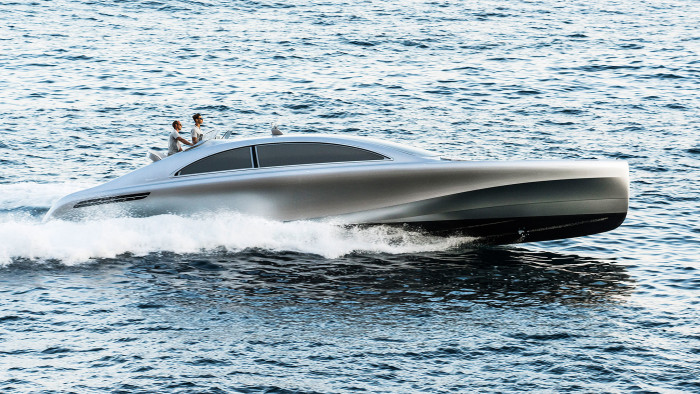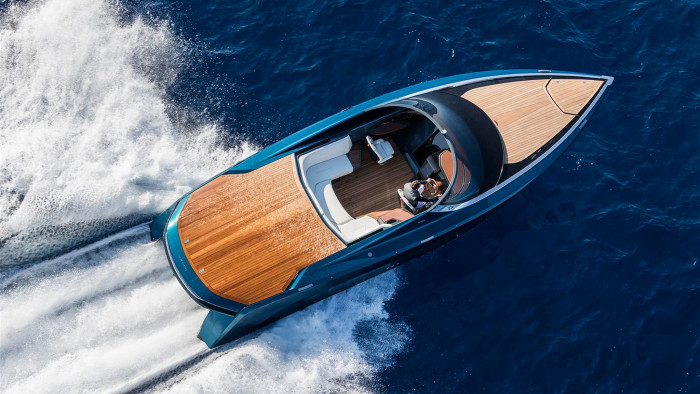Boats by Bugatti, Aston Martin, Lexus and Mercedes make a splash

Roula Khalaf, Editor of the FT, selects her favourite stories in this weekly newsletter.
When the Aston Martin AM37 powerboat, engineered by Quintessence Yachts, made its debut at the Monaco Yacht Show in 2016, the car company’s design director, Marek Reichman, described it as “a pure translation of the Aston Martin DNA into a . . . maritime concept”.
But the AM37, with a speed of up to 50 knots, is not the only yacht to marry boat and car design. Mercedes too has lent its style to the new Arrow460-Granturismo, a collaboration between UK-based motor yacht builder Silver Arrows Marine and the Mercedes-Benz Style advanced design centre on Lake Como in Italy. Gorden Wagener, chief design officer at Daimler, Mercedes’ parent company, has described the 460-GT as the marine cousin to its leading sports cars such as the S-Class.
Some yachts have little more than a branding connection with a car marque. But the 460-GT, says Ron Gibbs, chairman of Silver Arrows Marine, is “merging marine and automotive worlds, with their respective design language, technologies and ideas”. In addition to the input of Mercedes car designers, the company drew on the expertise of naval architects Martin Francis and Tommaso Spadolini.
The result is a sleek powerboat that delivers a combined 880 horsepower with a top speed of 38 knots; a more powerful version is available. A pre-production model of the yacht is on the water and the yacht is scheduled to go into production at the Baltic Yachts yard in Finland in October.
Differing motivations are driving these efforts. At Mercedes the project arose from designers discussing ideas in an airport lounge when their flight was delayed. For Aston Martin and Bugatti, another high-end carmaker moving into yachts, the aim was to expand their reach into the market for luxury goods.

When Bugatti announced plans to build its Chiron sports car in 2015, its biggest challenge was to fill orders for a production run of 500 units. More than half have been sold so far and the first were delivered earlier this year. Now Bugatti, in collaboration with the boatbuilder Palmer Johnson, has announced a matching powerboat, the Niniette 66, which costs €4m and comes with a jacuzzi and an onboard fire pit. It plans a larger $10m model and smaller versions at prices yet to be confirmed.
For Toyota, the creation of a powerboat has been an exercise to sharpen the skills of its designers, says Yoshihiro Sawa, president of its luxury car division, Lexus. Not to be outclassed by European technology, Lexus has built a sports yacht powered by engines from Toyota’s marine division. Only one has been built so far and there are no plans to put it into production.

Beyond these collaborations, motor industry expertise is also beginning to permeate more fully into the top ranks of production yachtmakers.
While boats are not produced in the same volume as cars, manufacturing disciplines learnt from the motor industry such as just-in-time ordering are helping to streamline production in the UK’s biggest production boatyards. “We’re much more data-driven in our decision-making than we were,” says Phil Popham, chief executive of Sunseeker, who joined the Poole-based UK boat builder in 2014 from Jaguar Land Rover where he had been group marketing director. “The motor industry is quite mature in terms of its planning and governance and taking a long-term view. That’s certainly what we have brought in to Sunseeker,” he says.
Antony Sheriff joined Plymouth-based rival Princess Yachts as executive chairman in January 2016 after 10 years as managing director of McLaren Automotive. He works alongside Kiran Haslam, the company’s marketing director, who joined from Bentley Motors two years ago. “In many respects there are worlds of difference between the two industries,” says Mr Haslam. “The automotive industry has had 100 years to develop a core structure that must meet with complex processes and compliance demands, and that means long development cycles.
“Boat manufacturing is more of a cottage industry and takes less time to get things done. Our boats are powered using established marine engines and where we have complexity it’s related to size and scale, salinity, vibration and the pounding delivered by the sea.”

For some motor companies, marine production is embedded within the business. At Swedish motor manufacturer Volvo, marine exposure is valuable since its Volvo Penta marine engines are used in many types of commercial and leisure craft. For some years the company has sponsored the Volvo Ocean Race that gives it a branding presence in race-stage ports across the world.
Sometimes, however, the design impetus flows in the other direction: Princess has linked up with Bentley Motors, inspiring a nautical-themed Bentley with a walnut-decking console. The Galene, which has a planned production run that will be limited to 30 vehicles, is white with a blue stripe to evoke the sea.

Comments